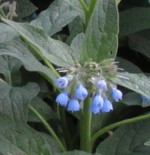 This coarse herbaceous perennial is native to the Caucasus Mountains where it grows in waste places, along roadsides, in scrub, and along streams. It is a member of the boarage family, Boraginaceae, that also includes Virginia bluebell, forget-me-nots, and heliotrope. Slender rhizomes with long thick roots form a rosette of leaves and then erect sparsely branched stems that become sprawling. The ovate to lanceolate leaves are grayish green and softly hairy. The basal leaves are up to eight inch long while the upper leaves are six inches long and attached to the stem for a short distance. The bell-shaped flowers are drooping, ¾ “ long, and are carried in terminal, arching, paired, scorpiod cymes in spring to early summer. They open pink aging to sky blue and the petals are considerably longer than the sepals. Plants grow quickly and can be invasive. The genus name, Symphytum, comes from two Greek words, symphyo meaning make to grow together, and phyton, meaning plant, and refers to the reputed healing properties of the genus.
This coarse herbaceous perennial is native to the Caucasus Mountains where it grows in waste places, along roadsides, in scrub, and along streams. It is a member of the boarage family, Boraginaceae, that also includes Virginia bluebell, forget-me-nots, and heliotrope. Slender rhizomes with long thick roots form a rosette of leaves and then erect sparsely branched stems that become sprawling. The ovate to lanceolate leaves are grayish green and softly hairy. The basal leaves are up to eight inch long while the upper leaves are six inches long and attached to the stem for a short distance. The bell-shaped flowers are drooping, ¾ “ long, and are carried in terminal, arching, paired, scorpiod cymes in spring to early summer. They open pink aging to sky blue and the petals are considerably longer than the sepals. Plants grow quickly and can be invasive. The genus name, Symphytum, comes from two Greek words, symphyo meaning make to grow together, and phyton, meaning plant, and refers to the reputed healing properties of the genus.
Type: Herbaceous perennial
Bloom: Arching clusters of pink bell-shaped flowers aging to blue in spring and early summer
Size: 18-24” H x 24” W
Light: Sun to part shade
Soil: Average, moist, well-drained
Hardiness: Zones 3-8
Care: Contain to control growth
Pests and Diseases: None of significance
Propagation: Division in spring, root cuttings
Companion plants: Magnolia, bergenia, ferns, Caucasian peony, western bleeding heart, columbine